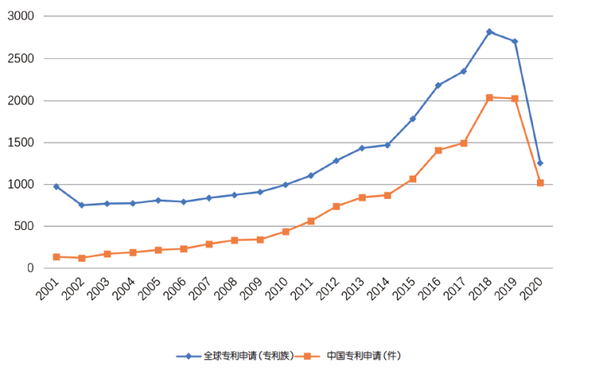Patent empirical analysis of opportunities and challenges for the development of 6G communications in China

Compared with 2G communication network, 3G realizes mobile broadband, but the real demonstration of the role of mobile broadband is in the 4G era. Compared with 4G, the 5G communication network puts more emphasis on the Industrial Internet of Things and the Internet of Everything, but related application scenarios and killer applications are still in the early stages of construction, and the true effect may not be until the 6G era. The global competition of the current new generation of mobile communication technology (6G) has quietly staged.

The goal of mobile communication is to achieve "interconnection", which forms the industrial characteristics of the upstream and downstream of the industrial chain to strictly abide by the international communication standards. The patent laws of various countries generally stipulate that without the permission of the patentee, no entity or individual may exploit its patent, that is, it shall not manufacture, use, promise to sell, sell, import its patented products, or use its patented methods and methods for production and business purposes. Use, promise to sell, sell, and import products directly obtained in accordance with the patented method. Therefore, once you have an Essential Standard Patent (ESP), you can ban the sale of competitors' products and request to stop using products that infringe on patent rights. This is equivalent to controlling the entrances and exits of expressways and toll stations, forming a huge control over the industry, and it is bound to be in an important position in the industry competition. Competing for standard-essential patents has also become one of the primary tasks of competition in the communications industry.
6G communication standard patent layout has entered a critical period
Seizing standard-essential patents requires high time requirements. The internationally accepted patent systems all have novelty requirements. Simply put, patents must be applied for before the standard is publicly used and published, otherwise the novelty of the patent application will be lost. Therefore, the patent layout of the 6G communication standard must be ahead of the formation of the standard. The standardization of 6G network technical specifications will begin in 2023. It is by no means too early to study and discuss 6G patent issues, but time is pressing and time is not waiting.
Looking back at the era of 5G communications, my country’s communications industry has actively invested in research and development since its early days, and has proposed a series of important technical solutions such as full-duplex and Polar codes. Although full-duplex did not enter the 5G communication standard in the end, in our domestic and foreign manufacturer surveys on 6G patents, manufacturers basically reached a consensus that full-duplex technology will be an important candidate technology for 6G.
Five years have passed since the technical voting for the 5G standard. During these five years, Sino-US trade frictions have occurred and the international competition environment for Chinese ICT manufacturers has deteriorated. Facing the critical period before the formation of the 6G communication standard, how can China’s communication industry better integrate its patent layout?
Vertically and horizontally, it is vital to form an effective joint force and layout to deal with external pressure. In this regard, there is no doubt that scientific research institutes, equipment vendors, and operators in China's communications industry are aware of the overall interests of the country and industry development. However, it is very important to grasp the intricate technology and patent situation and form a clear working idea in a technological frontier field such as mobile communication.
Opportunities and challenges of China's communications industry in 6G patents
What is the number of 6G patents? The German patent data company IPlytics counts the 5G standard essential patents declared in the European Telecommunications Standards Institute (ETSI). 5G communications currently has 21,571 patent families and 95,526 patents, of which 24 % Also declared 4G standard essential patents before. According to this ratio, there should be about 5,000 patent families for 5G continuation technologies that have a high probability of entering the 6G standard. In the 6G patent research conducted by the State Intellectual Property Office, it was also found that Qualcomm’s
The United States patent "US10652908B2, a delay-sensitive service dynamic prioritization method and device" was declared as an essential patent for the TS38.321 standard of 3GPP 5G on March 13, 2020, and this patent is also likely to enter 6G standard. The 6G patent research we have carried out, in the current early stage of 6G technology research and development, includes about 3.8 patent families in the four branches of "THz", "Air, Space and Haiti Integration", "Deterministic Network" and "AI Air Interface". As major companies in the communications industry play games with each other and make their choices clear, the number of patents involved in the specific formation of standards may be less than this number.
A big data analysis of the 38,000 patent families involved in 6G communications reveals that the subject is patent applications after 2011. Correspondingly, the patents included in 4G are mainly applied for after 1997. However, the independent innovation of patents in my country's communications industry started relatively late, and only applied for the first mobile communications patent in 1997, that is, the TD-SCDMA standard essential patent CN97104039.7 applied by Mr. Li Shihe of Xinwei Communications. And 6G mainly relies on patent applications after 2010, which provides objective and powerful conditions for my country's independent innovation to seize the commanding heights of 6G. Figure 1 shows the annual trend of the number of 6G patent applications in the world and China.

Figure 1 Annual trend of the number of patent applications for 6G in the world and China
From the perspective of the development trend of 6G patents, the number of patents in the United States ranked first during the period from 2001 to 2009, while the number of applications in China, Europe, Japan and South Korea is not much different. After 2009, the number of applications from China began to increase rapidly, significantly surpassing the United States, Europe, Japan, and South Korea. At the same time, China is also the main target country in key 6G technology areas, followed by the United States and Japan.
As for the 6G technology that has foreign technological advantages, my country must step up tracking and catch up. For example, in terms of high-altitude platform communication technology, China started late in battery and related antenna technology, and only started patent applications in 2015. In terms of link management, related patent applications of foreign applicants involve management and control of different link modes, and patent applications continue to appear, but domestic attention is relatively low on patent applications in this area. In terms of deterministic network technology, European and American companies have a long history of technological innovation and ample patent reserves. However, China is still in the stage of joint research and development of "production, study and research", and its independent intellectual property creation and reserves in deterministic network technology are relatively weak. It is recommended that domestic innovation entities pay more attention to the development trend of international superior technologies,
The research and development of corresponding patents has shifted from pursuing quantity to improving quality in the layout of patents, promoting breakthroughs in key core technologies, and supporting the high-quality development of patents.
A prominent phenomenon in my country's current 6G technology research and development is that colleges and universities and scientific research institutions occupy the top ten patent applications for 6G key technologies in China. From the ranking of the number of patent applicants in China, it can be seen that the top ten applicants include 8 applicants from colleges and universities, 2 applicants from scientific research institutes, and no applicants from enterprise. According to statistics from the Ministry of Education, the implementation and transformation of patents in my country's universities urgently need to be strengthened. The patent conversion rate of Chinese universities is generally less than 10%, while the patent conversion rate of high-level universities in the United States is about 40%. There is a big gap between the patent conversion of Chinese universities and foreign high-level universities. Integrating domestic "industry-university-research" superior resources to promote patent transformation is an important topic for independent innovation of 6G patents.
6G key technology deterministic network patent risk
The mature and widely used deterministic network technology with high reliability and low latency is one of the most important demands of the industry for 6G communications. From the perspective of network evolution trends, with the development of 5G to B market services, mobile communication networks have gradually transformed from the service consumer Internet to the service industry Internet, and have gradually become the technical foundation of the industrial Internet and the Internet of Vehicles. The further integration of ICT and OT promotes the evolution of mobile communication networks from providing "best effort" rigid channels to providing "deterministic" on-demand customized network services. Time-sensitive services impose extreme requirements on network performance. With the development of industrial manufacturing, Internet of Vehicles, and smart grid services, mobile communication networks need to support deterministic service transmission while supporting ultra-low latency.
However, China's deterministic network technology started later than Europe and the United States, and the number of patent applications is about half of that of the United States. U.S. and European data equipment manufacturers (such as Cisco, Intel, etc.) and large manufacturing manufacturers (such as General Electric, Siemens, Airbus, etc.)
Cars, etc.) have a large number of patent applications. Cisco in the United States has declared standard essential patents in the IETF. With the continuous integration of information technology and operation technology, Ethernet and mobile communication network technologies continue to cross-border integration, and deterministic network technology has begun to enter 3GPP’s 5G R16 and R17 standards, and well-known mobile device manufacturers (such as Qualcomm, Nokia, Ericsson, Huawei, Samsung, Intel, etc.) have all started patent layout. Currently, there are 9 essential patents on time-sensitive network technology declared in ETSI. I believe that with the development of the Industrial Internet, more standard-essential patents will be declared.
【Editor's Choice】